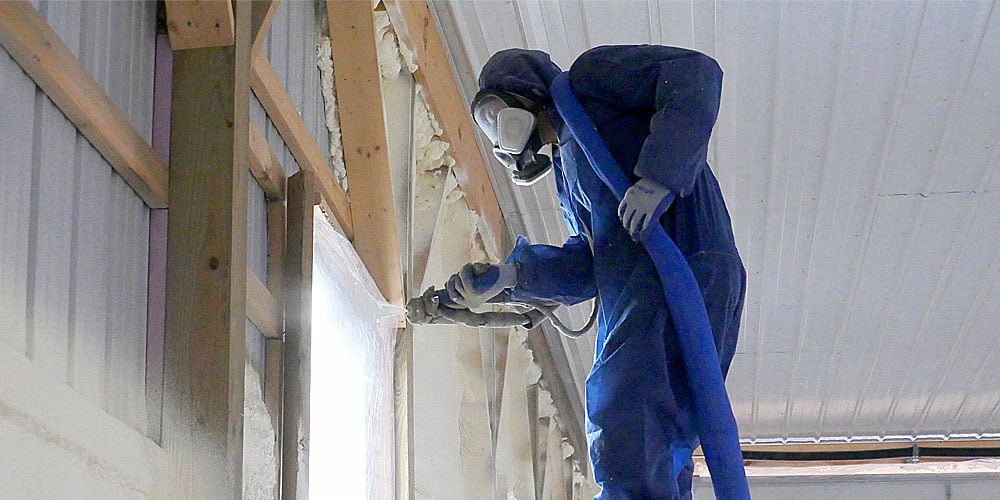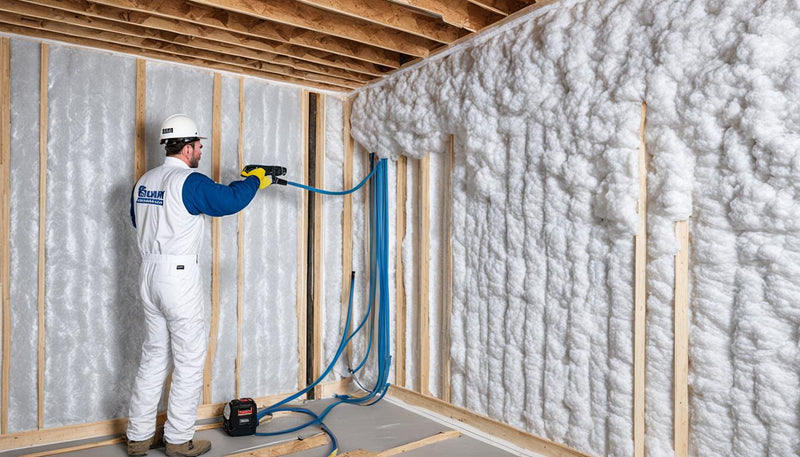Tips for Preserving Your Spray Foam Insulation for Long-Term Performance
Spray Foam: The Ultimate Solution for Air Sealing and Insulation
Spray foam insulation has arised as a leading remedy for effective air securing and thermal insulation, supplying an one-of-a-kind combination of properties that establish it apart from standard methods. Recognizing the full scope of its benefits, setup procedures, and contrasts with other insulation kinds is vital for making notified decisions.
What Is Spray Foam?
Spray foam is a functional insulation material that combines the concepts of air sealing and thermal resistance to boost energy efficiency in structures. Composed largely of polyurethane or other comparable compounds, spray foam is used as a liquid that expands upon contact with surfaces, producing a solid, constant layer of insulation. This unique property enables it to fill gaps, fractures, and spaces that standard insulation materials may ignore, supplying a superior air seal.
There are 2 main sorts of spray foam: open-cell and closed-cell. Open-cell spray foam is lighter and much more adaptable, providing superb sound absorption and a reduced R-value per inch - Spray Foam. On the other hand, closed-cell spray foam is denser, offering a greater R-value, moisture resistance, and added architectural integrity to developing elements
The application procedure usually entails specialized devices, making certain a seamless application that adheres to numerous substratums, including metal, timber, and concrete. This adaptability makes spray foam appropriate for both brand-new building and constructions and retrofitting existing structures. Its capability to develop an impermeable barrier substantially contributes to decreasing energy usage and boosting interior air quality, thus making it a recommended choice among home builders and homeowners alike.
Advantages of Spray Foam Insulation
One of the most significant advantages of spray foam insulation is its extraordinary capability to produce a constant air obstacle, which successfully decreases power loss. Unlike typical insulation products, spray foam expands to load voids and cracks, making certain that air leak is significantly minimized. This characteristic not only improves energy effectiveness but likewise results in lower utility bills with time.
Additionally, spray foam insulation gives remarkable thermal resistance, adding to a much more stable interior setting. Its high R-value per inch permits effective insulation in constrained rooms, making it suitable for attics, walls, and crawl rooms. The moisture-resistant properties of spray foam help protect against mold and mildew and mildew development, promoting much healthier living conditions.
An additional vital benefit of spray foam insulation is its sound-dampening top qualities (Spray Foam). It efficiently lowers noise transmission in between rooms, developing a quieter and much more comfy home environment. The longevity of spray foam also sticks out, as it does not sag or clear up over time, preserving its efficiency throughout its lifespan
Exactly How Spray Foam Functions
Understanding just how spray foam insulation functions is vital for valuing its effectiveness in air sealing and thermal resistance. Spray foam insulation contains two main parts: isocyanate and polyol resin. When these elements are blended, they undertake a chain reaction that triggers the product to increase rapidly, producing a thick foam that loads dental caries, gaps, and fractures.
As the foam increases, it abides by surfaces, forming a closed seal that substantially lowers air seepage. This particular makes spray foam insulation highly effective at protecting against drafts and moisture penetration, which can lead to energy loss and damage in time. Furthermore, the closed-cell variation of spray foam provides exceptional thermal resistance because of its stiff structure, efficiently lessening warm transfer.
The distinct residential properties of spray foam enable it to comply with uneven surfaces, guaranteeing extensive coverage and a seamless obstacle. Therefore, spray foam insulation not just improves energy efficiency yet additionally adds to enhanced indoor air quality by lowering the buildup of irritants and contaminants. Inevitably, recognizing the technicians browse around this site behind spray foam emphasizes its function as an exceptional choice for insulation and air securing in both business and property applications.
Installment Process Review

Prior to installment, the space should be appropriately cleaned and prepped, guaranteeing that surfaces are without particles, dampness, and dirt. This step is vital due to the fact that impurities can compromise adhesion and overall performance. When the location is prepared, the application includes mixing both elements of the spray foam, which broadens upon contact and fills her response gaps efficiently.
Trained professionals should conduct the installment, making use of customized tools to make sure uniform protection and optimal thickness. Safety and security preventative measures, consisting of using protective gear and making certain correct air flow, are imperative during this procedure. After application, the foam normally remedies rapidly, forming a strong obstacle that improves energy performance.
Comparing Spray Foam to Conventional Insulation
When assessing insulation options, spray foam insulation stands out in contrast to typical products such as fiberglass and cellulose. Unlike fiberglass and cellulose, which can allow air infiltration, spray foam expands upon application, filling up holes and voids to develop a closed seal.
Furthermore, spray foam offers a higher R-value per inch than traditional insulation kinds, offering more reliable thermal resistance in a thinner account. This characteristic is especially useful in spaces with minimal tooth cavity deepness. Additionally, spray foam is immune to wetness and mold development, which can be a considerable worry about cellulose and fiberglass, especially in moist environments.
However, spray foam insulation usually lugs a higher upfront expense than its standard counterparts. House owners must consider this first investment against lasting energy financial savings and performance advantages. Inevitably, while both insulation kinds serve their function, spray foam arises as a much more sophisticated solution for modern-day insulation demands, especially in regards to air securing and thermal effectiveness.

Conclusion
In summary, spray foam insulation stands for an extremely effective option for achieving ideal air sealing and thermal resistance. Its unique buildings, including wetness resistance and noise dampening, make it ideal for numerous applications in both new constructions and retrofitting tasks (Spray Foam). Although the preliminary costs may be greater contrasted to standard insulation products, the long-lasting advantages, such as substantial energy financial savings and boosted indoor air quality, justify the financial investment and underscore its value in modern-day structure methods.
Spray foam insulation has actually emerged as a leading service for reliable air sealing and thermal insulation, providing a distinct combination of residential properties that establish it apart from standard methods.Spray foam is a flexible insulation material that incorporates the principles of air sealing and thermal resistance to enhance energy performance in structures.When examining insulation choices, spray foam insulation stands out in comparison to typical products such as fiberglass and cellulose. Eventually, while both insulation kinds serve their objective, spray foam emerges as a much more innovative option for modern insulation requirements, particularly in terms of air securing and thermal performance.
In summary, spray foam insulation stands pop over here for an extremely effective option for attaining ideal air sealing and thermal resistance.